Pat Nevin did also did an interesting piece on corners Nevin: Why have corners got worse?
The Value of a Corner Kick
By Michael Caley
Corner kicks are not particularly valuable events in soccer. When the defending team knocks the ball out behind their goal line, this is usually a positive defensive action, as possession around the penalty area is dangerous. Corner kicks, while they can produce goals, do so only quite rarely. It is not always clear when watching matches that the players know this.
This last weekend in the Premier League saw a moment where a players decision not to play a ball out for a corner kick cost his team a goal. In Tottenham’s match against Southampton, Spurs fullback Ben Davies was put in a difficult situation. A very poor back pass by Ryan Mason left Davies fending off Southampton striker Graziano Pellè in the centre of the 18-yard-box. With the big Italian striker bearing down on him, Davies had no chance to spin and try to drive the ball out of play for a throw. But if he simply passed the ball behind the end line he could concede a corner at the chance would be over. Instead of conceding the corner, however, Davies attempted to shield the ball back to his keeper. He failed, Pellè got to the ball and his shot easily beat a very angry Hugo Lloris for the first goal of the match.
The chance that Davies conceded was huge, the kind of shot a striker should score maybe twice out of five chances or more. How do those odds compare to the value of a corner kick?
They compare very well. I ran a new study to estimate the value of corner kicks to account for a series of other variables, including whether there is a penalty called on the ensuing corner or for shots taken after a poor clearance. Using data from the past two seasons in the English Premier League, the German Bundesliga and the Spanish Primera Division, I identified nearly 20,000 corner kicks. I tracked whether these corner kicks eventually produced shots, whether on headers directly assisted by the corner or within the same attacking move. Including penalties, about ten percent of shots from corner kicks are scored. This gives a rough value of a corner kick at around 0.035 goals. Conceding a big chance in order to avoid giving up a 3.5 percent chance at scoring does not look like a good decision.

Further, there is another variable to consider. In last Sunday’s match between Everton and Manchester United, the first goal came off a corner kick situation. Manchester United won an early corner, conceded by Everton left back Leighton Baines. United sent its biggest players forward, including center back Chris Smalling. When the corner was cleared, the defenders were out of position. Fullback Antonio Valencia got beaten easily by Everton’s Romelu Lukaku, and the break was on. With United’s best defenders committed to attacking the corner kick, it was that much easier for Everton’s counterattack to reach the danger zone. James Mcarthy beat David De Gea for the game’s first goal, and the Everton upset was on.
There is, then possible attacking value from a corner kick conceded. The more players a team commits forward to playing the corner, the more vulnerable they are to a quick counterattack up the gut.
From the roughly 13,000 corner kicks which did not result in a shot, about 1,800 lead to a counterattack that reached the opposition final third. There were 526 shots from counterattacks off corners and 72 of them were scored. That is a scoring rate about 40 percent better than average. This means that when a team concedes a chance from a counterattack, it is often a high quality chance like McCarthy’s.

Overall, compared with a scoring rate from corner kicks of about 3.5 percent, there is also a goals-conceded rate of about 0.4 percent. Add them together and you get an average value for a corner kick at about 0.03 goals.
So when defenders are under any kind of pressure around the danger zone and have a chance to play a ball out for a corner, they should take it. The chance conceded is no more risky than a speculative shot from 30 yards out, and it might even give their team a good attacking opportunity the other way.

